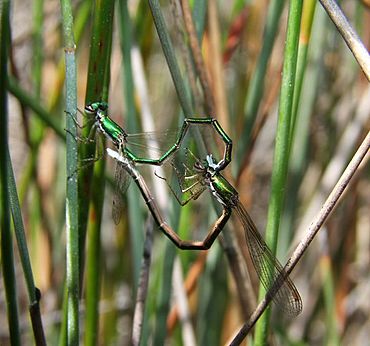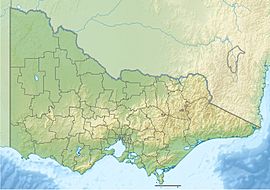Discovery Bay Coastal Park facts for kids
Quick facts for kids Discovery Bay Coastal ParkVictoria |
|
|---|---|
|
IUCN Category V (Protected Landscape/Seascape)
|
|

Ancient Greenling (damselfly)
|
|
| Nearest town or city | Portland and Mount Gambier |
| Established | 1979 |
| Area | 104.6 km2 (40.4 sq mi) |
| Managing authorities | Parks Victoria |
| Website | Discovery Bay Coastal Park |
| Footnotes | |
| Official name: Glenelg Estuary and Discovery Bay Ramsar Site | |
| Designated: | 28 February 2018 |
| Reference #: | 2344 |
| See also | Protected areas of Victoria |
The Discovery Bay Coastal Park is a special protected area along the coast in western Victoria, Australia. It stretches for about 50 kilometers (31 miles) along Discovery Bay. This park is a very important place for nature and wildlife. It is also part of the traditional lands of the Gunditjmara people.
A famous walking trail, the Great South West Walk, goes through parts of the park. The Discovery Bay Marine National Park is right next to this park, near Cape Bridgewater.
History of the Park
The idea for this coastal park was first suggested in 1973. It officially became a protected park in 1979. Over the years, more land was added to the park in 1981, 1987, and 1997.
In 2018, parts of the coastal park became a Ramsar site. This means it is recognized as a wetland of international importance. This special area is called the Glenelg Estuary and Discovery Bay Ramsar Site.
Nature and Wildlife
Landforms and Rocks
The land here is made of basalt rock, which is a type of volcanic rock. On top of this, there is limestone. The coast has rugged cliffs and headlands, especially at Cape Nelson and Cape Bridgewater.
Further inland, you can find large areas of sand dunes. There are also swamps and freshwater lakes. These limestone areas contain very old Pleistocene animal fossils.
Plants and Animals
Over 320 different kinds of native plants grow in Discovery Bay Coastal Park. A very important wetland here is called Long Swamp. It gets its water from underground.
- Plants in the Swamp: The water levels in Long Swamp have been getting lower. This has caused a plant called bare twig-sedge to grow more. Its seeds are a favorite food for the ground parrot. As the water keeps dropping, another plant, Woolly Tea-tree, is starting to take over.
- Ancient Greenling: This swamp is also a key home for an endangered damselfly called the ancient greenling.
The park is part of a larger area known as the Discovery Bay to Piccaninnie Ponds Important Bird Area. This area is globally important for many bird species.
- Beach Birds: Two threatened birds, the hooded plover and little tern, build their nests right on the beaches.
- Wetland Birds: Birds like the ground parrot, Australasian bittern, and brolga live in the wetlands.
- Dune and Shrubland Birds: The orange-bellied parrot, rufous bristlebird, striated fieldwren, and beautiful firetail have been seen in the dunes and shrublands.
- Fish: Rare fish species, such as the Yarra pygmy perch and dwarf galaxias, live in the park's waters.
- Mammals: You might find mammals like the long-nosed potoroo, heath mouse, and swamp antechinus here.
- Seals: There are also colonies of Australian fur seals on the rocky platforms at Capes Nelson and Bridgewater.


